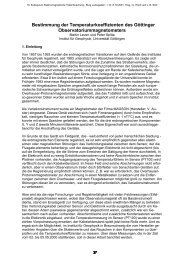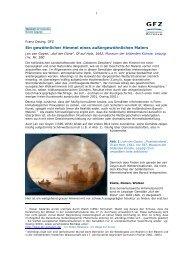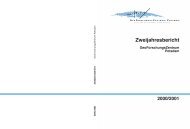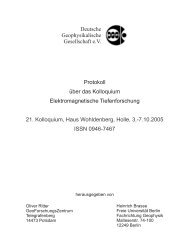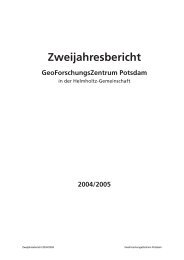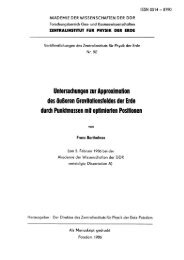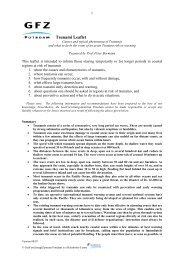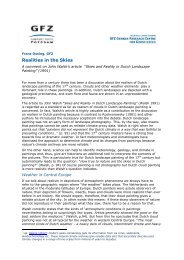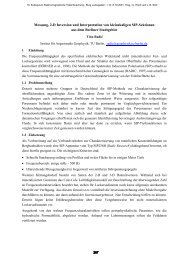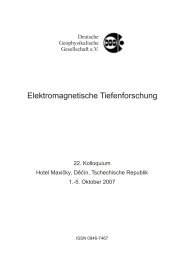A 3D magnetotelluric study of the basement structure in the ... - GFZ
A 3D magnetotelluric study of the basement structure in the ... - GFZ
A 3D magnetotelluric study of the basement structure in the ... - GFZ
Create successful ePaper yourself
Turn your PDF publications into a flip-book with our unique Google optimized e-Paper software.
A <strong>3D</strong> <strong>magnetotelluric</strong> <strong>study</strong> <strong>of</strong> <strong>the</strong> <strong>basement</strong> <strong>structure</strong> <strong>in</strong> <strong>the</strong> Mygdonian Bas<strong>in</strong><br />
(Nor<strong>the</strong>rn Greece)<br />
SUMMARY<br />
M. Gurk 1,5 , M. Smirnov 2,3 , A.S. Savvaidis 1 , L. B. Pedersen 3 and O. Ritter 4<br />
1 Institute <strong>of</strong> Eng<strong>in</strong>eer<strong>in</strong>g Seismology and Earthquake Eng<strong>in</strong>eer<strong>in</strong>g (ITSAK), Greece<br />
2 University <strong>of</strong> Oulu, F<strong>in</strong>land<br />
3 University <strong>of</strong> Uppsala, Sweden<br />
4 GeoForschungsZentrum Potsdam (<strong>GFZ</strong>), Germany<br />
5 Institut für Geophysik, Universität zu Köln, Germany<br />
Dur<strong>in</strong>g 2006 and 2007 a total number <strong>of</strong> 92 MT/GDS sites were deployed <strong>in</strong> <strong>the</strong> Mygdonian bas<strong>in</strong> (Nor<strong>the</strong>rn Greece) to<br />
ga<strong>in</strong> knowledge about <strong>the</strong> <strong>basement</strong> <strong>structure</strong> by means <strong>of</strong> 2D and <strong>3D</strong> MT data <strong>in</strong>version and to give <strong>in</strong>formation about<br />
<strong>the</strong> top-<strong>of</strong>-<strong>basement</strong> depth for seismic wave propagation models. The <strong>structure</strong> <strong>of</strong> <strong>the</strong> <strong>basement</strong> is fairly well revealed<br />
by <strong>the</strong> data.<br />
Keywords: MT, GDS, Mygdonian bas<strong>in</strong>, top-<strong>of</strong>- <strong>basement</strong>, 2D <strong>in</strong>version, <strong>3D</strong> <strong>in</strong>version<br />
INTRODUCTION<br />
The Mygdonian bas<strong>in</strong>, situated between <strong>the</strong> two lakes Volvi and Lagada ca. 45 km nor<strong>the</strong>ast <strong>of</strong> Thessaloniki (Fig.<br />
1&2), is a neotectonic graben <strong>structure</strong> (5 km wide) with significant seismic activity along dist<strong>in</strong>ct normal fault patterns<br />
(Papazachos et al., 1979; Karagianni et al., 1999; Goldsworthy et al., 2002). Fluvioterrestrial and lacustr<strong>in</strong>e sediments<br />
(approximately 200-600 m thick) are overly<strong>in</strong>g <strong>the</strong> <strong>basement</strong> consist<strong>in</strong>g <strong>of</strong> gneiss-schists.<br />
Figure 1: Map <strong>of</strong> <strong>the</strong> Aegean See with <strong>the</strong> location <strong>of</strong> <strong>the</strong> survey area (white box).<br />
Dur<strong>in</strong>g <strong>the</strong> project “Euroseistest<br />
Volvi-Thessaloniki”, a European test<br />
site for Eng<strong>in</strong>eer<strong>in</strong>g Seismology was<br />
<strong>in</strong>stalled <strong>in</strong> order to <strong>study</strong> velocity<br />
cross sections across <strong>the</strong> funnel<br />
shaped valley. With <strong>the</strong> actual EM<br />
survey we <strong>in</strong>tend to map <strong>the</strong> top-<strong>of</strong><strong>basement</strong><br />
and to contribute to seismic<br />
wave propagation modell<strong>in</strong>g process<br />
and site effect assessment (Jongmans<br />
et al. 1998; Manakou et al., 2004;<br />
Savvaidis et al., 2004; Raptakis et al.,<br />
2005).<br />
22. Kolloquium Elektromagnetische Tiefenforschung, Hotel Maxičky, Děčín, Czech Republic, October 1-5, 2007<br />
239
Figure 2: Map <strong>of</strong> <strong>the</strong> <strong>study</strong> area with MT site locations (triangles), Villages (red polygon), 2-D l<strong>in</strong>es and geological<br />
outl<strong>in</strong>es (above). Bird view towards <strong>the</strong> North-East, show<strong>in</strong>g topography and MT site locations (below).<br />
22. Kolloquium Elektromagnetische Tiefenforschung, Hotel Maxičky, Děčín, Czech Republic, October 1-5, 2007<br />
240
MT/GDS SURVEY<br />
Dur<strong>in</strong>g 2006/2007 a total number <strong>of</strong> 92 MT/GDS sites were <strong>in</strong>stalled <strong>in</strong> <strong>the</strong> Mygdonian bas<strong>in</strong> (Fig. 2). The sites were<br />
measured roughly on a regular grid (North-South and East-West) reflect<strong>in</strong>g <strong>the</strong> predom<strong>in</strong>ant East-West orientation <strong>of</strong><br />
many normal faults <strong>in</strong> this area. The site spac<strong>in</strong>g on this grid is approximately 1 km. Some areas <strong>in</strong> <strong>the</strong> mounta<strong>in</strong> and<br />
around villages are not covered due to <strong>the</strong> <strong>in</strong>creased EM noise or due to <strong>in</strong>accessibility.<br />
MT and GDS data were collected us<strong>in</strong>g three MTU-2000 <strong>in</strong>struments (utiliz<strong>in</strong>g Earth Data PR6-24 loggers,<br />
http://www.earthdata.co.uk/prod.html) comb<strong>in</strong>ed with Metronix MFS05 coils from Uppsala University<br />
(http://88.198.212.158/mtxweb/<strong>in</strong>dex.php?id=53). One <strong>of</strong> <strong>the</strong>se <strong>in</strong>struments was used to collect remote reference data<br />
Burst mode dur<strong>in</strong>g<br />
night, 120 m<strong>in</strong>utes<br />
Night and day<br />
record<strong>in</strong>g<br />
Day record<strong>in</strong>g ca.<br />
120 m<strong>in</strong>utes<br />
Day record<strong>in</strong>g ca.<br />
120 m<strong>in</strong>utes<br />
Sample<br />
frequency<br />
1 kHz<br />
20 Hz<br />
3 kHz<br />
120 Hz<br />
Table 1: Sampl<strong>in</strong>g frequencies and record<strong>in</strong>g times<br />
dur<strong>in</strong>g <strong>the</strong> entire survey time. Due to <strong>the</strong> limited amount <strong>of</strong> <strong>in</strong>duction coils,<br />
we were not able to collect <strong>the</strong> vertical magnetic field at each site. The<br />
horizontal electric field components Ex and Ey were measured with grounded<br />
non-polarisable Pb/PbCl electrodes. Where possible, <strong>the</strong> electrode spac<strong>in</strong>g<br />
was extended to a maximum <strong>of</strong> 100 m us<strong>in</strong>g a symmetric cross shaped<br />
configuration, hav<strong>in</strong>g <strong>the</strong> ground electrode <strong>in</strong> its centre (differential <strong>in</strong>put).<br />
Generally, time series data were recorded <strong>in</strong> four frequency bands with <strong>the</strong><br />
sampl<strong>in</strong>g frequencies and sample times shown <strong>in</strong> Table 1. In <strong>the</strong> follow<strong>in</strong>g we<br />
display all spatial data <strong>in</strong> <strong>the</strong> metric Greek coord<strong>in</strong>ate system EGSA-87.<br />
Figure 3: Unrotated apparent resistivities versus period for all sites (left: a-xy, right: a-yx).<br />
DATA PROCESSING & ANALYSIS<br />
Based on this survey design we obta<strong>in</strong>ed reliable estimates <strong>of</strong> <strong>the</strong> MT transfer function for 92 sites <strong>in</strong> <strong>the</strong> period range<br />
from T= 0.001 s to 1 s for day time recod<strong>in</strong>g and from T= 0.001 s to 1000 s for <strong>the</strong> sites where both day and night<br />
record<strong>in</strong>gs were available (ca. 70% <strong>of</strong> <strong>the</strong> data).<br />
The time series were processed with <strong>the</strong> robust remote reference code <strong>of</strong> Smirnov (2003). All permutations <strong>of</strong> remote<br />
reference sites from <strong>in</strong>side and outside <strong>of</strong> <strong>the</strong> <strong>study</strong> area were used to estimate transfer functions. Also several time<br />
segments for 1 kHz and 3 kHz record<strong>in</strong>gs were processed <strong>in</strong>dependently and <strong>the</strong>reafter averaged toge<strong>the</strong>r with long<br />
period data to obta<strong>in</strong> <strong>the</strong> f<strong>in</strong>al estimates <strong>of</strong> <strong>the</strong> MT transfer functions. Dur<strong>in</strong>g robust averag<strong>in</strong>g us<strong>in</strong>g <strong>the</strong> reduced Mestimator<br />
we calculated error bars based on bootstrap method.<br />
Additionally, MT/GDS data were available from a 1995 survey (Savvaidis et. al., 2000; Makris et al, 2002) measured<br />
with a seven channel S.P.A.M. MkIII system (Ritter et al., 1998) coupled with Metronix MFS05 magnetic sensors. The<br />
orig<strong>in</strong>al time series were reprocessed with <strong>the</strong> Egbert code (Egbert, 1997) us<strong>in</strong>g standard 128 s time w<strong>in</strong>dows for <strong>the</strong><br />
dist<strong>in</strong>ct frequency bands. From this 1995 survey, 9 MT sites <strong>in</strong> a period range <strong>of</strong> T= 0.008 s – 100 s were used for <strong>the</strong><br />
2D and <strong>3D</strong> <strong>in</strong>version.<br />
22. Kolloquium Elektromagnetische Tiefenforschung, Hotel Maxičky, Děčín, Czech Republic, October 1-5, 2007<br />
241
Figure 4: 2D resistivity models <strong>of</strong> l<strong>in</strong>e A-E (from top to bottom).<br />
Triangles <strong>in</strong>dicate MT site locations.<br />
In order to validate <strong>the</strong> 2D <strong>in</strong>version, we<br />
carried out strike and dimensionality<br />
analysis. The strike analysis <strong>of</strong> <strong>the</strong> MT data<br />
revealed two predom<strong>in</strong>ant strike directions:<br />
For short periods up to ca. T= 3 s, a local<br />
strike <strong>of</strong> approximately 0° / 90 ° is found,<br />
whereas for longer periods a regional strike<br />
<strong>of</strong> about 135° / 45 ° can be deduced from<br />
<strong>the</strong> MT data. The regional and local strike<br />
is consistent with previous results <strong>of</strong> MT<br />
data from this area (Makris et al, 2002). For<br />
longer periods, real parts <strong>of</strong> <strong>in</strong>duction<br />
arrows are po<strong>in</strong>t<strong>in</strong>g towards <strong>the</strong> South-West<br />
show<strong>in</strong>g a regional strike direction <strong>of</strong> about<br />
N120°E. The overall GDS data quality<br />
from <strong>the</strong> 2006/2007 survey is poor thus we<br />
did not use <strong>the</strong>m for any 2D and <strong>3D</strong><br />
<strong>in</strong>version tasks. At this time this behaviour<br />
is not well understood, s<strong>in</strong>ce GDS data<br />
from <strong>the</strong> 1995 survey (Savvaidis et. al.,<br />
2000) and a recent GDS <strong>in</strong>strument test<br />
(Gurk, pers. comm.) show good GDS<br />
results. Dimensionality parameter did not<br />
show significant <strong>3D</strong> effects <strong>in</strong> <strong>the</strong> data,<br />
allow<strong>in</strong>g us to use 2D <strong>in</strong>version techniques.<br />
2D INVERSION<br />
Generally, <strong>the</strong> MT data are <strong>of</strong> good quality.<br />
However before <strong>in</strong>version, each MT<br />
transfer function has been carefully<br />
exam<strong>in</strong>ed. The ma<strong>in</strong> impedance<br />
components as well as <strong>the</strong> Berdichevsky<br />
impedance tensor determ<strong>in</strong>ant average data<br />
(short: Berdichevsky Invariant;<br />
Berdichevsky et. al., 1976), were tested for<br />
consistency by us<strong>in</strong>g 1D <strong>in</strong>version. After<br />
this procedure, MT data from 74 sites (out<br />
<strong>of</strong> 92 measured) have been chosen for <strong>the</strong><br />
2D and <strong>3D</strong> modell<strong>in</strong>g.<br />
All selected sound<strong>in</strong>g curves used for this <strong>study</strong> are presented <strong>in</strong> Figure 3. The 2D <strong>in</strong>version was performed along five<br />
parallel pr<strong>of</strong>iles (A-E) strik<strong>in</strong>g N30°E at quasi equal distances. Each MT site was <strong>the</strong>n projected on <strong>the</strong> accord<strong>in</strong>g<br />
pr<strong>of</strong>ile. In order to perform <strong>the</strong> 2D <strong>in</strong>version, we followed <strong>the</strong> strategy <strong>of</strong> Pedersen & Engels, (2005) <strong>in</strong>vert<strong>in</strong>g only<br />
Berdichevsky Invariant data. S<strong>in</strong>ce <strong>the</strong> Berdichevsky Invariant is by def<strong>in</strong>ition rotationally <strong>in</strong>variant, any variability <strong>in</strong><br />
strike direction with period does not affect <strong>the</strong> results as much as for bi-modal <strong>in</strong>version, when <strong>the</strong> proper mode<br />
decomposition is vital.<br />
The 2D <strong>in</strong>version rout<strong>in</strong>e by Siriponvaraporn and Egbert (2000) <strong>in</strong>clud<strong>in</strong>g <strong>the</strong> modifications made by Pedersen and<br />
Engels (2005) allow for <strong>in</strong>version <strong>of</strong> <strong>the</strong> Berdichevsky Invariant. Error floors equal to 2% for <strong>the</strong> impedance phase<br />
(correspond<strong>in</strong>g to an absolute error <strong>of</strong> 1.2°) and 50 % for <strong>the</strong> apparent resistivities were adopted. S<strong>in</strong>ce <strong>the</strong>re was no<br />
22. Kolloquium Elektromagnetische Tiefenforschung, Hotel Maxičky, Děčín, Czech Republic, October 1-5, 2007<br />
242
o<strong>the</strong>r <strong>in</strong>formation <strong>in</strong> order to constra<strong>in</strong> <strong>the</strong> static shift effect and <strong>the</strong> site spac<strong>in</strong>g is relatively small, we have chosen a<br />
higher error floor for <strong>the</strong> resistivity data compared to <strong>the</strong> phases to allow <strong>the</strong> <strong>in</strong>version procedure to have more freedom<br />
to compensate for <strong>the</strong>se effects.<br />
F<strong>in</strong>ally, a homogeneous halfspace <strong>of</strong> 100 m was used as <strong>the</strong> start<strong>in</strong>g model for all 2D <strong>in</strong>versions. This procedure<br />
resulted <strong>in</strong> an overall good fit <strong>of</strong> <strong>the</strong> measured data to <strong>the</strong> model (RMS 1). The series <strong>of</strong> <strong>the</strong> 2D <strong>in</strong>version results shown<br />
<strong>in</strong> Figure 4 <strong>in</strong>dicate an <strong>in</strong>crease <strong>in</strong> complexity <strong>of</strong> <strong>the</strong> conductivity distribution towards <strong>the</strong> East that is likely to be<br />
caused by a more complicated <strong>3D</strong> geological sett<strong>in</strong>g <strong>in</strong> this part <strong>of</strong> <strong>the</strong> survey area. Hence a simplified 2D analysis <strong>of</strong><br />
<strong>the</strong> MT transfer function can be mislead<strong>in</strong>g <strong>in</strong> <strong>the</strong>se regions. Consequently we proceed with a <strong>3D</strong> <strong>in</strong>version <strong>of</strong> <strong>the</strong> data<br />
set.<br />
<strong>3D</strong> INVERSION<br />
The same data set, consist<strong>in</strong>g <strong>of</strong> 74 pre-selected good quality MT sites, was used for <strong>the</strong> <strong>3D</strong> <strong>in</strong>version (Siriponvaraporn<br />
et al., 2005). Until now, <strong>the</strong> code does not account for topographic <strong>in</strong>formation, nor for vertical magnetic fields.<br />
Generally, MT data were measured on a more or less regular grid <strong>in</strong> <strong>the</strong> 12 km x 6 km survey area with an approximate<br />
site distance <strong>of</strong> about 1 km.<br />
After choos<strong>in</strong>g <strong>the</strong> orig<strong>in</strong> <strong>of</strong> <strong>the</strong> model doma<strong>in</strong> at <strong>the</strong> location <strong>of</strong> MT site a1309 it was necessary to shift <strong>the</strong> MT sites<br />
accord<strong>in</strong>gly to <strong>the</strong>ir new position <strong>in</strong> <strong>the</strong> model doma<strong>in</strong>. To get an even site distribution we allowed for relatively large<br />
lateral shifts <strong>of</strong> those sites that where measured directly on <strong>the</strong> outcropp<strong>in</strong>g <strong>basement</strong> rocks, e. g. <strong>in</strong> <strong>the</strong> Nor<strong>the</strong>rn part <strong>of</strong><br />
<strong>the</strong> area (Fig. 5). The model grid itself was designed to have 4 cells between each site. Dur<strong>in</strong>g <strong>the</strong> first <strong>in</strong>version trial<br />
we have selected only 3 periods <strong>in</strong> <strong>the</strong> range from T= 1 s - 0.01 s. Therefore, <strong>the</strong> grid was constructed to be a 34 x 34 x<br />
21 matrix <strong>in</strong>clud<strong>in</strong>g additional 5 horizontal outer cells to extend <strong>the</strong> grid boundaries to 60 km.<br />
distance x [m]<br />
4506000<br />
4504000<br />
4502000<br />
4500000<br />
4498000<br />
Lake<br />
Sediments<br />
Sediments<br />
Sediments<br />
Gneiss<br />
Sediments<br />
Gneiss<br />
Sediments<br />
434000 436000 438000 440000 442000 444000<br />
distance y [m]<br />
Figure 5: Plan view <strong>of</strong> <strong>the</strong> central part <strong>of</strong> <strong>the</strong> model grid (denoted as crosses) toge<strong>the</strong>r with <strong>the</strong> MT site location<br />
(triangles), <strong>the</strong> MT site location <strong>in</strong> <strong>the</strong> model doma<strong>in</strong> (circles) and geological outl<strong>in</strong>es. The red circle <strong>in</strong>dicates <strong>the</strong><br />
centre <strong>of</strong> <strong>the</strong> grid.<br />
The second <strong>in</strong>version run <strong>in</strong>cluded 8 periods <strong>in</strong> <strong>the</strong> range <strong>of</strong> T= 10 s– 0.01 s, us<strong>in</strong>g <strong>the</strong> same model grid, whereas for <strong>the</strong><br />
third <strong>in</strong>version <strong>the</strong> number <strong>of</strong> cells <strong>in</strong>-between sites were <strong>in</strong>creased and a better vertical discrim<strong>in</strong>ation at target depths<br />
(42 x 54 x 26 cells) was applied. For <strong>the</strong> <strong>3D</strong> <strong>in</strong>version we have used <strong>the</strong> complete impedance tensor (Zxx, Zxy, Zyx &<br />
Zyy). After 4 successful iterations <strong>of</strong> <strong>the</strong> <strong>3D</strong> rout<strong>in</strong>e <strong>the</strong> <strong>in</strong>version code reached RMS values <strong>of</strong> approximately 10.<br />
22. Kolloquium Elektromagnetische Tiefenforschung, Hotel Maxičky, Děčín, Czech Republic, October 1-5, 2007<br />
243<br />
Lake<br />
Granite
distance x [m]<br />
distance x [m]<br />
4506000<br />
4504000<br />
4502000<br />
4500000<br />
4498000<br />
4506000<br />
4504000<br />
4502000<br />
4500000<br />
4498000<br />
planview at depth z= 60 m<br />
434000 436000 438000 440000 442000 444000<br />
distance y [m]<br />
planview at depth z= 250 m<br />
434000 436000 438000 440000 442000 444000<br />
distance y [m]<br />
22. Kolloquium Elektromagnetische Tiefenforschung, Hotel Maxičky, Děčín, Czech Republic, October 1-5, 2007<br />
244<br />
3<br />
2.8<br />
2.6<br />
2.4<br />
2.2<br />
2<br />
1.8<br />
1.6<br />
1.4<br />
1.2<br />
1<br />
0.8<br />
3<br />
2.8<br />
2.6<br />
2.4<br />
2.2<br />
2<br />
1.8<br />
1.6<br />
1.4<br />
1.2<br />
1<br />
0.8<br />
log10 rho [Ohm m]<br />
log10 rho [Ohm m]
distance x [m]<br />
4506000<br />
4504000<br />
4502000<br />
4500000<br />
4498000<br />
planview at depth z= 800 m<br />
434000 436000 438000 440000 442000 444000<br />
distance y [m]<br />
Figure 6: Plan view <strong>of</strong> <strong>3D</strong> resistivity models at three different depths (triangles <strong>in</strong>dicate MT site locations, hashed l<strong>in</strong>es<br />
<strong>in</strong>dicate geological boundaries).<br />
Figure 6 shows representative examples <strong>of</strong> <strong>the</strong> <strong>3D</strong> <strong>in</strong>version results <strong>of</strong> our last run as pla<strong>in</strong> view at three different<br />
depths. The resistivity <strong>of</strong> <strong>the</strong> lacustr<strong>in</strong>e sediments (approx. 40 m) <strong>in</strong> <strong>the</strong> valley contrasts clearly with <strong>the</strong> higher<br />
resistivities <strong>of</strong> <strong>the</strong> surround<strong>in</strong>g <strong>basement</strong> rocks allow<strong>in</strong>g to map <strong>the</strong> <strong>structure</strong>s at near surface (z = 60 m) <strong>in</strong> very good<br />
accordance to <strong>the</strong> geological sett<strong>in</strong>g as displayed <strong>in</strong> Figure 2. In a larger depth range at z= 250 m, <strong>the</strong> <strong>in</strong>fluence <strong>of</strong> a<br />
<strong>basement</strong> high is more pronounced towards <strong>the</strong> centre <strong>of</strong> <strong>the</strong> area. The sediments (approx. 40-60 m) <strong>in</strong> <strong>the</strong> Eastern<br />
part <strong>of</strong> <strong>the</strong> area seem to vanish whereas <strong>in</strong> <strong>the</strong> Western part sediments are still visible. At a depth <strong>of</strong> z= 800 m only<br />
sediments <strong>in</strong> <strong>the</strong> South Western part <strong>of</strong> <strong>the</strong> valley are still recognisable, <strong>the</strong> <strong>basement</strong> high <strong>in</strong> <strong>the</strong> middle <strong>of</strong> <strong>the</strong> valley is<br />
now fully developed and <strong>the</strong> sediments towards <strong>the</strong> East are not pronounced any more.<br />
The normalised absolute misfit <strong>of</strong> <strong>the</strong> real part <strong>of</strong> <strong>the</strong> impedance tensor elements Zxy and Zyx are shown <strong>in</strong> Figure 7.<br />
The data misfit is higher <strong>in</strong> <strong>the</strong> Western part <strong>of</strong> <strong>the</strong> area than compared to <strong>the</strong> Eastern part, which is <strong>in</strong> agreement to <strong>the</strong><br />
previous 2D model <strong>study</strong>. Large misfits can be found where <strong>the</strong> MT site distribution and/or data quality is poor. It is a<br />
strik<strong>in</strong>g feature <strong>in</strong> Figure 6 that <strong>the</strong> misfit follows <strong>the</strong> topography or morphology <strong>of</strong> <strong>the</strong> survey area which could mean<br />
that static shift and/or topographic effects may play a more important role <strong>in</strong> <strong>the</strong> error distribution than previously<br />
considered. Hence <strong>the</strong> entire data set should be re-analysed more carefully with respect to galvanic distortion models.<br />
<strong>3D</strong> MODEL VOLUME<br />
The <strong>3D</strong> <strong>in</strong>version results at dist<strong>in</strong>ct depth values can be presented us<strong>in</strong>g volume render<strong>in</strong>g tools. S<strong>in</strong>ce our task is to<br />
map <strong>the</strong> top-<strong>of</strong>-<strong>basement</strong> by means <strong>of</strong> an iso-resistivity layer, we have to conf<strong>in</strong>e <strong>the</strong> range <strong>of</strong> resistivity values that can<br />
be associated with <strong>the</strong> top-<strong>of</strong>-<strong>basement</strong> rocks. Due to <strong>the</strong> chang<strong>in</strong>g hydrogeological conditions which leads to different<br />
degrees <strong>of</strong> wea<strong>the</strong>r<strong>in</strong>g <strong>of</strong> <strong>the</strong> <strong>basement</strong> rocks, it is not possible to allocate a unique resistivity value to <strong>the</strong> top–<strong>of</strong><strong>basement</strong>.<br />
Never<strong>the</strong>less, we can use available <strong>in</strong>formation from boreholes and VES data (Euroseistest, 1995; Tournas,<br />
2005) to constra<strong>in</strong> <strong>the</strong> resistivity range and <strong>the</strong> depth to <strong>the</strong> <strong>basement</strong> rocks at specific locations. Our first approach is<br />
displayed <strong>in</strong> Figure 8 to highlight <strong>the</strong> onset <strong>of</strong> <strong>the</strong> <strong>basement</strong> resistivities, <strong>in</strong>dicated by <strong>the</strong> transition between yellow and<br />
green colors (approx. 75 m). From <strong>the</strong>se considerations a 90 m iso-surface can be deduced that matches sufficiently<br />
to <strong>basement</strong> <strong>in</strong>formation from boreholes (see Fig. 9). Study<strong>in</strong>g <strong>the</strong> conductivity distribution <strong>in</strong> general with <strong>in</strong> <strong>the</strong> <strong>3D</strong><br />
22. Kolloquium Elektromagnetische Tiefenforschung, Hotel Maxičky, Děčín, Czech Republic, October 1-5, 2007<br />
245<br />
3<br />
2.8<br />
2.6<br />
2.4<br />
2.2<br />
2<br />
1.8<br />
1.6<br />
1.4<br />
1.2<br />
1<br />
0.8<br />
log10 rho [Ohm m]
volume, we see that <strong>the</strong> sediments with <strong>the</strong> lowest resistivities can be found <strong>in</strong> a band along <strong>the</strong> Sou<strong>the</strong>rn rim <strong>of</strong> <strong>the</strong><br />
valley. Towards <strong>the</strong> North, <strong>the</strong> resistivities <strong>of</strong> <strong>the</strong> sediments <strong>in</strong>crease gradually.<br />
distance x [m]<br />
distance x [m]<br />
4506000<br />
4504000<br />
4502000<br />
4500000<br />
4498000<br />
4506000<br />
4504000<br />
4502000<br />
4500000<br />
4498000<br />
plan view <strong>of</strong> <strong>the</strong>r normalized absolute misfit <strong>of</strong> RE Zxy at T= 0.016 s<br />
434000 436000 438000 440000 442000 444000<br />
distance y [m]<br />
plan view <strong>of</strong> <strong>the</strong>r normalized absolute misfit <strong>of</strong> RE Zyx at T= 0.016 s<br />
434000 436000 438000 440000 442000 444000<br />
distance y [m]<br />
Figure 7: Plan view <strong>of</strong> <strong>the</strong> normalized absolute misfit at T= 0.016 s for <strong>the</strong> real part <strong>of</strong> <strong>the</strong> impedance tensor elements<br />
Zxy (up) and Zyx (below). Triangles <strong>in</strong>dicate MT site locations, hashed l<strong>in</strong>es <strong>in</strong>dicate geological boundaries.<br />
22. Kolloquium Elektromagnetische Tiefenforschung, Hotel Maxičky, Děčín, Czech Republic, October 1-5, 2007<br />
246<br />
10<br />
9<br />
8<br />
7<br />
6<br />
5<br />
4<br />
3<br />
2<br />
1<br />
0<br />
10<br />
9<br />
8<br />
7<br />
6<br />
5<br />
4<br />
3<br />
2<br />
1<br />
0<br />
normalized absolute misfit<br />
normalized absolute misfit
Figure 8: Two <strong>3D</strong> bird views <strong>of</strong> <strong>the</strong> resistivity model <strong>in</strong> North-East direction. Triangles <strong>in</strong>dicate MT sites.<br />
22. Kolloquium Elektromagnetische Tiefenforschung, Hotel Maxičky, Děčín, Czech Republic, October 1-5, 2007<br />
247
Figure 9: <strong>3D</strong> view <strong>of</strong> <strong>the</strong> top <strong>of</strong> <strong>basement</strong> (90 m iso-surface, green color) <strong>in</strong> North-East direction. Triangles <strong>in</strong>dicate<br />
MT sites.<br />
CONCLUSIONS<br />
MT array data were used to obta<strong>in</strong> new <strong>in</strong>formation about <strong>the</strong> sediment thickness and <strong>the</strong> slope <strong>of</strong> <strong>the</strong> top-<strong>of</strong>-<strong>basement</strong><br />
<strong>in</strong> <strong>the</strong> South-Eastern part <strong>of</strong> <strong>the</strong> <strong>in</strong>vestigation area which is <strong>of</strong> particular importance for seismic wave propagation<br />
model<strong>in</strong>g. To support this f<strong>in</strong>d<strong>in</strong>g <strong>in</strong> our future work new MT sites are go<strong>in</strong>g to be deployed to stretch <strong>the</strong> 2D sections<br />
A, B and C towards <strong>the</strong> South-East. In <strong>the</strong> next <strong>in</strong>version attempt, we pay more attention to galvanic and topographic<br />
effects, as well as to conf<strong>in</strong>e <strong>the</strong> model results with available VES and RMT/CSTAMT <strong>in</strong>formation.<br />
ACKNOWLEDGEMENTS<br />
This <strong>study</strong> is supported by <strong>the</strong> project <strong>of</strong> <strong>the</strong> Marie Curie Action ITSAK-GR (International Transfer <strong>of</strong> Seismological<br />
Advanced Knowledge – Geophysical Research), MTCD-CT-2005-029627. We are greatly <strong>in</strong>debted to <strong>the</strong> students from<br />
Thessaloniki and Crete who took part <strong>in</strong> <strong>the</strong> fieldwork. F<strong>in</strong>ally we would like to thank Lars Dynesius for all his<br />
technical help and support dur<strong>in</strong>g <strong>the</strong> field measurements.<br />
22. Kolloquium Elektromagnetische Tiefenforschung, Hotel Maxičky, Děčín, Czech Republic, October 1-5, 2007<br />
248
REFERENCES<br />
Berdichevsky, M.N. and Dmitriev, V.I., (1976), Basic pr<strong>in</strong>ciples <strong>of</strong> <strong>in</strong>terpretation <strong>of</strong> <strong>magnetotelluric</strong> sound<strong>in</strong>g curves, <strong>in</strong><br />
Adam A., Ed., Geoelectric and geo<strong>the</strong>rmal studies: Budapest, Akamdemai Kiado, 165-221.<br />
Egbert, G.D. (1996). Robust Multiple-Station Magnetotelluric Data Process<strong>in</strong>g, Geophys. J. Int., 130, 475–496.<br />
EUROSEISTEST, (1995): ‘Volvi-Thessaloniki: A European Test Site for Eng<strong>in</strong>eer<strong>in</strong>g Seismology, Earthquake<br />
Eng<strong>in</strong>eer<strong>in</strong>g & Seismology’, F<strong>in</strong>al Scientific Report, October 1995.<br />
Goldsworthy, M., J. Jackson and J. Ha<strong>in</strong>es (2002) . The cont<strong>in</strong>uity <strong>of</strong> active fault systems <strong>in</strong> Greece, Geophys. J. Int.,<br />
148, 596–618.<br />
Jongmans,D., Pitilakis, K., Demanet, D., Raptakis, D., Hor-rent, C., Tsokas, G., Lontzetidis, K., Riepl, J., (1998).<br />
EURO-SEISTEST: Determ<strong>in</strong>ation <strong>of</strong> <strong>the</strong> Geological Structure <strong>of</strong> <strong>the</strong> Volvi Graben and validation <strong>of</strong> <strong>the</strong> bas<strong>in</strong> response<br />
to one earthquake and one shot. Bull. Seismol. Soc. Am. 88, 473–487.<br />
Karagianni, E.E., D.G. Panagiotopoulos, C.B. Papazachos, and P.W. Burton (1999). A <strong>study</strong> <strong>of</strong> shallow crustal <strong>structure</strong><br />
<strong>in</strong> <strong>the</strong> Mygdonia Bas<strong>in</strong> (N. Greece) based on <strong>the</strong> dispersion curves <strong>of</strong> Rayleigh waves. Journal <strong>of</strong> <strong>the</strong> Balkan<br />
Geophysical Society, Vol. 2, No 1, 3-14.<br />
Manakou M. Raptakis D., Chavez-Garcia F., Makra K., Apostolidis P. Pitilakis K., (2004), Construction <strong>of</strong> <strong>the</strong> <strong>3D</strong><br />
geological <strong>structure</strong> <strong>of</strong> Mygdonian bas<strong>in</strong> (N. Greece), <strong>in</strong> proceed<strong>in</strong>gs <strong>of</strong>: 5 th International Symposium on eastern<br />
Mediterranean Geology, Thessaloniki, Greece, 14-20. April, Ref: S6-15<br />
Makris J. P., Savvaidis, A. and Valliantos, F. (2002). MT-data analysis from a survey <strong>in</strong> <strong>the</strong> Mygdonian bas<strong>in</strong> (N.<br />
Greece). Anals <strong>of</strong> Geophysics 45, 303-311.<br />
Papazachos, B.C., Mountrakis, D., Psilovikos, A., and Leventakis, G., (1979). Surface fault traces and fault plane<br />
solutions <strong>of</strong> <strong>the</strong> May-June 1978 major shocks <strong>in</strong> <strong>the</strong> Thessaloniki area, Greece, Tectonophysics, 53, 171-183<br />
Pedersen, L.B. and Engels, M. (2005). Rout<strong>in</strong>e 2D <strong>in</strong>version <strong>of</strong> Magnetotelluric data us<strong>in</strong>g <strong>the</strong> determ<strong>in</strong>ant <strong>of</strong> <strong>the</strong><br />
impedance tensor. Geophysics 70, G33-G41.<br />
Raptakis D., Manakou M., Chavez-Garcia F., Makra K., Pitilakis K., (2005), <strong>3D</strong> configuration <strong>of</strong> Mygdonian bas<strong>in</strong> and<br />
prelim<strong>in</strong>ary estimate <strong>of</strong> its site response, Soil dynamics and Earthquake Eng<strong>in</strong>eer<strong>in</strong>g, 25, 871-887.<br />
Ritter, O., Junge, A., Graham, J., Dawes K., (1998). New equipment and process<strong>in</strong>g for <strong>magnetotelluric</strong> remote<br />
reference observations. Geophys. J. Int, 132, 535-548.<br />
Savvaidis, A. Pedersen, L. B., Tsokas, G. N., Dawes, G. J., (2000). Structure <strong>of</strong> <strong>the</strong> Mygdonian Bas<strong>in</strong> (N. Greece)<br />
<strong>in</strong>ferred from MT and gravity data, Tectonophysics, 317, 171-186.<br />
Savvaidis A., Theodoulidis N., Panou A., Papazachos C. and Hatzidimitriou P., (2004). Geophysical Information from<br />
Ambient Noise Data <strong>in</strong> <strong>the</strong> Volvi Bas<strong>in</strong>, 10th Congress <strong>of</strong> <strong>the</strong> Geological Society <strong>of</strong> Greece, Thessaloniki, Greece, 15 -<br />
17 April 2004.<br />
Siripunvaraporn W. and Egbert G, (2000). An efficient data-subspace <strong>in</strong>version method for 2-D <strong>magnetotelluric</strong> data.<br />
Geophysics, 65, 791–803.<br />
Siripunvaraporn W., G. Egbert, Y. Lenbury and M. Uyeshima. (2005). Three-Dimensional Magnetotelluric: Data Space<br />
Method, Physics <strong>of</strong> <strong>the</strong> Earth and Planetary Interiors, 150, 3-14.<br />
Smirnov, M., (2003). Magnetotelluric data process<strong>in</strong>g with a robust statistical procedure hav<strong>in</strong>g a high breakdown<br />
po<strong>in</strong>t, Geophys.J.Int., 152, 1-7.<br />
Tournas, D., (2005). Study <strong>of</strong> <strong>the</strong> geometry <strong>of</strong> <strong>the</strong> Mygdonian Bas<strong>in</strong> <strong>in</strong> <strong>the</strong> area <strong>of</strong> <strong>the</strong> European Test Site with<br />
Geophysical Methods, MSc, Aristotle University, Thessaloniki (<strong>in</strong> Greek). pp. 145.<br />
22. Kolloquium Elektromagnetische Tiefenforschung, Hotel Maxičky, Děčín, Czech Republic, October 1-5, 2007<br />
249



